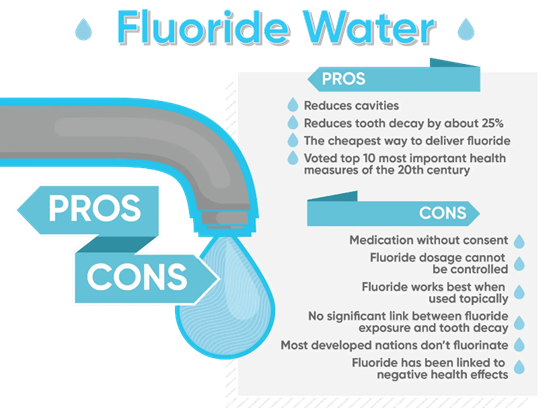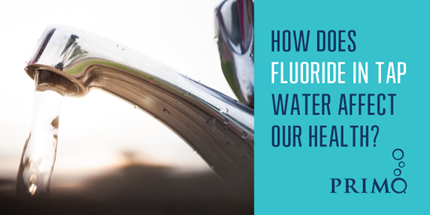Pros
and Cons: Adding Fluoride in Drinking Water
Note from the writer: SPOKANE, Wash. The City of Spokane would pay nearly $11 million in capital costs and millions more to maintain a system that would add fluoride to the city's drinking water. A fluoridation implementation study commissioned by the city was just released and will now be used for elected officials to consider when deciding whether to add fluoride.
Spokane has considered it several times
over the years, but has never made the decision to add fluoride to the water
system.
Spokane Mayor Nadine Woodward has said in the past she wants the issue to go to a public vote.
PAST COVERAGE: 'It should be on the ballot'
: Woodward says decision to fluoridate water should be up to voters. The Spokane City Council voted last year to study the issue and now the report is complete.
Many of the arguments against fluoride
are rooted in a fear of how it was first discovered and later introduced into
the United States’ water supply. Coupled with the fact that fluoride is most
beneficial during a child’s early and adolescent developmental stages, the
question of whether fluoride is good for you and your kids comes up quite often.
Recent Legislative Changes for Public
Water Systems
During this past Legislative Session,
House Bill 1251 was passed and signed by Governor Inslee on April 20, 2023. The
purpose of this bill is to set notification requirements for public water systems
that want to start adding fluoride to their drinking water, or systems that
would like to discontinue adding fluoride to their drinking water. Starting
July 23, 2023, public water systems considering starting or discontinuing
fluoridation of their water on a continuing basis must notify their customers
and ODW, at least 90 days prior to a vote or decision on the matter.
***
In the movie Dr. Strangelove, General Ripper claimed that water fluoridation was destroying “our precious bodily fluids”, a reference to the claim that water fluoridation was a conspiracy designed to weaken US willpower and make the country susceptible to a Communist takeover. Although there were occasional references to a Communist conspiracy in the anti-fluoridation movement in the United States and Canada, this was not a common feature of the debate. More commonly, opponents believed that they should not have to take medicine against their will. Much of the opposition focused on the possible health risks.
1- Controversy about adding fluoride or not in drinking water
·
2- Fluoride:
Safety or Danger?
Currently,
the national recommended allowance for fluoride in drinking water is 1
mg/L and toothpaste is 2 mg/L. WHO guidelines for
fluoride? Fluoridated toothpastes containing between 1000 and 1500 ppm fluoride
is the standard recommended by WHO as a public oral health measure for the
prevention of caries. This
has been approved by the US Environmental Protection Agency (EPA) and the
Centers for Disease Control and Prevention (CDC).
· Why is
fluoride banned in Europe? All
other treatment chemicals are added to treat the water (i.e. to improve the
water's quality and safety - which fluoride does not do). This is one of the
reasons why much of Europe has rejected fluoridation.
·
The
reason there are different opinions about the application of fluoride is due to
the concentration of this element present in the water source. Recently, the National Research Council (NRC) has
established a Research Council of dentists, toxicologists, and public health
experts. The research results were published in March 2006 in which the
preliminary conclusion was that the allowable concentration of fluoride in
domestic water was too high. With this permissible level), the Council
concluded that children using water with the above concentration for a long
time will damage teeth, and may reduce intelligence index (IQ). In
addition, if using this water throughout life, old age can cause osteoporosis,
and the risk of hip fracture is very high. And a group of Harvard professors
added to the conclusion that teenagers can develop bone cancer when drinking
fluoridated water.
According to research, if using water with a concentration
higher than 4 mg / L, the risk of tooth decay is highest, especially for
children. Historically in Hong Kong, since the introduction of fluoride into
drinking water, tooth decay among children and adolescents aged 6 to 19 has
increased from 23% in the late 1980s to 32% annually. 2006. It is estimated
that currently one in four
HK children has absorbed twice the amount of fluoride needed by the body.
That is why Professor Hardy Limeback of the University of Toronto added to the National Research Council that putting fluoride in toothpaste will be one of the ten mistakes of the 21st century.
· For
toothpastes that contain fluoride, it is required for the manufacturer to
clearly state on the label on the outside of the tube: Fluoride toothpaste is
packaged with the mandatory warning: “Keep out of reach of children under 6
years of age” by FDA. If more than used for brushing is accidentally swallowed,
get medical help or contact a Poison Control Center right away.”
·
Particularly, the Occupational Safety and
Health Administration (OSHA), requires workers working on bringing fluoride
into the water to wear protective clothing and gas masks. Workers in factories
related to fluorine often suffer from skin allergies and gastrointestinal
diseases due to the influence of fluorine gas released into the air.
Sometimes workers also die in severe cases. Fluoride is also classified as a
toxic chemical (poison) because fluoride in high concentrations is used
to kill rats and kill some pests in agriculture.
4-
PFAS may cause cancer!
According to a report by the US
Environmental Protection Agency (EPA), if people are exposed to or ingest too
much PFAS, it will be deposited in the blood, liver and kidneys, increasing the
risk of risks such as cancer, obesity. obesity, thyroid disease, high
cholesterol, infertility, liver disease, hormonal imbalance...
Recently, 3M reaches $10.3 billion
settlement over “forever chemicals” PFAS in public water systems.
5- How Fluoride
enters the human body.
The next question is: So, through the
above presentation, how does fluoride infect the body and affect humans?
6- In
Vietnam, which communities suffer from fluoride in soil and water?
In
Vietnam, water wells in Ninh Hoa at Nha Trang province contains fluoride levels
above 10 mg/L, so most people living here have fluorosis in their teeth. And in
2003, UNICEF gave a $3 million grant to install defluorination systems for the
population living in this area.
7-
And how about the effect of
Fluoride on intelligence?
For adults who have been exposed to fluoride for a long time, the American Medical Journal (AJM) published research results at the end of 2005 on a woman who had been exposed to fluoride and suffered from fluorosis. bone fluorosis, as well as joint pain with movement. This is because this woman has been drinking one to two gallons of tea continuously for over 20 years. She lives in an area with limestone and high fluoride content in the soil. According to the same study, the scientists estimated that the women had absorbed at least 10 mg of fluoride a day for more than 20 years, and the tea leaves had absorbed fluoride in the soil. Remember, Lipton Instant Tea we often see in the market has an average content of about 6.5 mg/L.
Also through the same medical journal, elderly people living in areas with high soil fluoride levels from 2 to 4 mg/kg, such as in Texas, Virginia, Oklahoma, were 41 percent more likely to have a hip fracture than those living in areas of low concentration.
The
questions below are from the extract of an article from Catherine Carstairs - Am J Public Health.
2015 August on Debating Water Fluoridation: “Most scientists doing
research in the field were very clearly identified as pro-fluoridation or anti-fluoridation,
with confusing ramifications for the public debate.
· Who
should members of the public believe in?
·
· Or the
far more lengthy and detailed books, leaflets, and pamphlets distributed by the
anti-forces that asserted that fluoride might lead to joint problems, heart and
kidney disease, and cancer? The
fact that the scientists and doctors appeared to be so divided may have
contributed to the perception that the experts were hiding evidence of possible
harm.
In fact, we must recognize the phenomenon
that fluoride accumulates in the body. Healthy adult kidneys
excrete 50 to 60% of the fluoride ingested each day (Marier & Rose 1971). The remainder
accumulates in the body, largely in calcifying tissues such as the bones and
pineal gland (Luke 1997, 2001).
Infants and children excrete less fluoride from their kidneys and take up to
80% of ingested fluoride into their bones (Ekstrand 1994). The fluoride concentration in bone steadily increases
over a lifetime (NRC 2006).
•
If we use chemicals to a certain extent, and with an appropriate dose,
chemicals will be a factor that helps us to solve many problems in life or
helps us to eliminate or prevent certain human diseases.
• If we use too much, the risk of adverse reactions will be unavoidable.
In
the case of fluorine is no exception. The American National Research
Council concluded that, after 55 years, it is safe to introduce fluoride into
domestic water sources less than 1mg/L (which already has naturally in
US soil. So we don’t need to add). There are specific results showing that the
presence of fluoride below these concentrations reduces the incidence of
tooth decay in children.
·
Finally, adding more fluoride into
drinking water, to me, you may have more risk of damaged teeth and gum
inflammation. Excess amounts of fluoride in drinking water can cause dental
fluorosis, skeletal fluorosis, arthritis, bone damage, osteoporosis, muscular
damage, fatigue, joint-related problems, and chronicle issues. And, according to Dr. Izabella
Wentz, ingesting too much
fluoride can cause damage to the thyroid gland and hypothyroid symptoms.
·
Speech
for 8/19/2023 at Spokane, WA













No comments:
Post a Comment